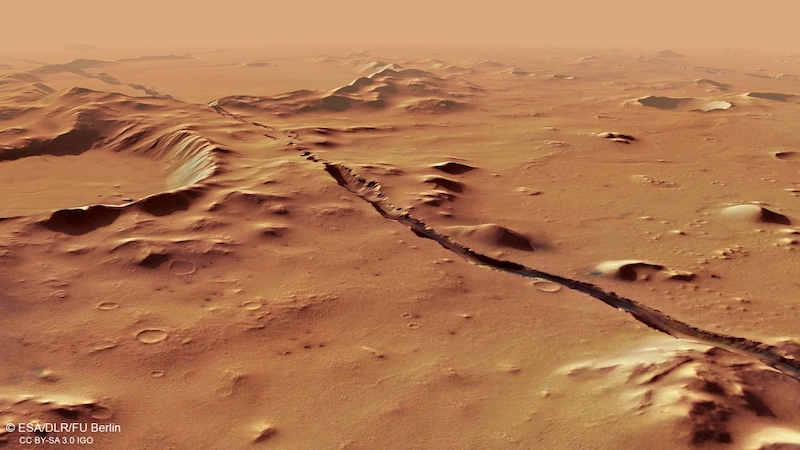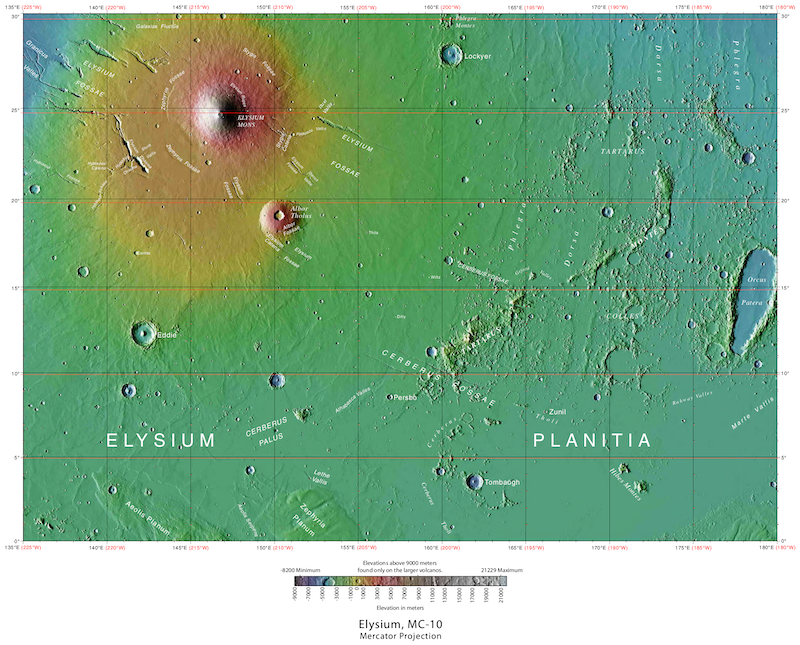
In November 2022, EarthSky reported on new evidence for magma still existing below the surface of Mars. And, on December 5, 2022, researchers at the University of Arizona said they’ve now found even more clues that the red planet is still volcanically active. A new analysis of orbital images of the Elysium Planitia region suggests a huge mantle plume of hot molten rock (magma) pushing upward from the mantle deep below. Such mantle plumes, also found on Earth, can cause earthquakes, faulting and volcanic eruptions. On Mars, this mantle plume likely drives much of the seismic activity – thousands of marsquakes – NASA’s InSight lander has detected in the region since 2018.
The researchers published the new peer-reviewed evidence in Nature Astronomy on December 5, 2022.
Huge blob of hot rock below the surface of Mars
Prior to more recent new discoveries, most planetary scientists thought that Mars was geologically dead. The evidence for current marsquakes and subsurface magma has upended that view, however. Now, the evidence for a giant and active mantle plume further challenges the old assumptions.
Scientists said the mantle plume, like ones on Earth, is a massive blob of hot magma. The researchers said it is pushing upward from deep inside the planet. This movement causes the marsquakes and subsurface volcanic activity. We should note that even on Earth, scientists still regard mantle plumes as a hypothesis. Albeit, however, one for which there is now substantial evidence.
As lead author Adrien Broquet, a postdoctoral research associate in the University of Arizona’s Lunar and Planetary Laboratory, said:
Our study presents multiple lines of evidence that reveal the presence of a giant active mantle plume on present-day Mars.
Co-author Jeffrey Andrews-Hanna also noted that:
We have strong evidence for mantle plumes being active on Earth and Venus, but this isn’t expected on a small and supposedly cold world like Mars. Mars was most active 3 to 4 billion years ago, and the prevailing view is that the planet is essentially dead today.
Broquet added:
A tremendous amount of volcanic activity early in the planet’s history built the tallest volcanoes in the solar system and blanketed most of the northern hemisphere in volcanic deposits. What little activity has occurred in recent history is typically attributed to passive processes on a cooling planet.
The Hawaiian Islands are a good example of this process on Earth. They formed as the Pacific tectonic plate, the Pacific Plate, drifted over top of a large mantle plume.
Elysium Planitia as a volcanic hotspot
One region of Mars in particular stands out for its volcanic activity: a huge, flat plain called Elysium Planitia. Although some other areas, like Tharsis, also have huge volcanoes, scientists said those volcanoes have been dead or dormant for billions of years (at least on the surface). In Elysium Planitia, however, scientists have found evidence for volcanic eruptions occurring within the past 200 million years. And even some eruptions much more recently, geologically speaking. Andrews-Hanna said:
Previous work by our group found evidence in Elysium Planitia for the youngest volcanic eruption known on Mars. It created a small explosion of volcanic ash around 53,000 years ago, which in geologic time is essentially yesterday.
Like the others, those volcanoes are no longer erupting on the surface. But the new findings suggest there is still at least residual volcanic activity happening below ground.

Marsquakes in Cerberus Fossae
There is also a volcanic connection between Elysium Planitia and a region within it called Cerberus Fossae. Fissures and faults in Cerberus Fossae stretch for more than 800 miles (1,287 km). Almost all the marsquakes detected by NASA’s InSight lander have originated in this region.
But why are there so many marsquakes in this one area? Earthquakes on our own planet provide a clue. They are associated with either plate tectonics or mantle plumes. Since Mars doesn’t have plate tectonics, the researchers investigated whether there could be a mantle plume below the surface in Cerberus Fossae. They looked closer at surface features in Elysium Planitia and found similarities with features on Earth. This included uplifting and stretching of the crust and molten rock from the subsurface plume. The plume erupts as molten basalts that create the volcanic plains. The paper stated:
The inferred plume head characteristics are comparable to terrestrial plumes that are linked to the formation of large igneous provinces.
The researchers found that although Elysium Planitia is a flat plain, something from below had uplifted its surface by more than a mile (1.6 km). Analysis of variations in the gravity of this region also showed that this upwelling is supported from deep below the surface. This is all consistent with a mantle plume. Even the floors of impact craters in the area tilt in the direction of the plume. This shows that the surface was pushed upward and stretched after the craters formed.
Mantle plume confirmed on Mars
The final piece of the puzzle fell in place when the researchers applied a tectonic model to the Elysium Planitia region. It revealed the presence of a mantle plume 2,500 miles (4,023 km) wide. As the paper noted:
Here we present observational evidence and geophysical models demonstrating that Elysium Planitia is underlain by an ~4,000-km-diameter active mantle plume head.
Broquet said:
In terms of what you expect to see with an active mantle plume, Elysium Planitia is checking all the right boxes. This mantle plume has affected an area of Mars roughly equivalent to that of the continental United States. Future studies will have to find a way to account for a very large mantle plume that wasn’t expected to be there.
We used to think that InSight landed in one of the most geologically boring regions on Mars, a nice flat surface that should be roughly representative of the planet’s lowlands. Instead, our study demonstrates that InSight landed right on top of an active plume head.
Life on Mars?
It’s possible that the heat from the plume could also melt ice deep below the ground. If so, that might create a habitable environment for microbes. As Andrews-Hanna noted:
Microbes on Earth flourish in environments like this, and that could be true on Mars, as well. Knowing that there is an active giant mantle plume underneath the Martian surface raises important questions regarding how the planet has evolved over time. We’re convinced that the future has more surprises in store.
We may no longer see huge eruptions of ash and lava on Mars, but that doesn’t mean the planet is dead. Indeed, it seems that deep down, Mars’ geological heart is still beating, even if you have to listen closely to hear it.
Bottom line: Researchers at the University of Arizona have found a massive plume of hot rock below the surface of Mars, showing that the planet is still volcanically active.
Source: Geophysical evidence for an active mantle plume underneath Elysium Planitia on Mars
The post More evidence Mars is still volcanically alive first appeared on EarthSky.
0 Commentaires